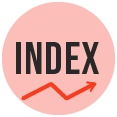
Jobs data points to rate rise
The Australian August job report blew expectations out of the water, with 64,900 jobs created in the month, well above the 23,000 anticipated by economists.

The S&P/ASX 200 Index (INDEXASX: XJO) is an Australian stock market index, created and maintained by Standard & Poor’s (S&P). It tracks the value of the 200 largest public companies ranked by their market capitalisation, adjusted for the shares that are actually available on the market. The S&P/ASX 200 will increase if enough companies see their share prices rise, and fall when they are sold down.
If you’re studying the stock market’s return over time, don’t forget about dividends. The XJO index does NOT include dividends paid by companies. If you want a more complete picture of the performance of Australian shares, use the S&P/ASX 200 Net Total Return Index (INDEXASX: XNT) index.
This chart shows performance of the index and S&P/ASX 200 Net Total Return (INDEXASX: XNT), which includes the impact of dividends being reinvested. The three most popular indices for Australian shares are the All Ordinaries (INDEXASX: XAO), S&P/ASX 200 Net Total Return (INDEXASX: XNT), and S&P/ASX 200 (INDEXASX: XJO).

The Australian August job report blew expectations out of the water, with 64,900 jobs created in the month, well above the 23,000 anticipated by economists.

Here’s today’s The Match Out report from Market Matters’ James Gerrish. Key point: the S&P/ASX 200 (INDEXASX: XJO) finished up +0.46% to 7186.50.

A tech slide dragged the ASX indices lower on Wednesday, ahead of the US inflation data coming in overnight.

Here’s today’s The Match Out report from Market Matters’ James Gerrish. Key point: the S&P/ASX 200 (INDEXASX: XJO) finished down +0.74% to 7153.90.

The benchmark S&P/ASX200 (INDEXASX: XJO) index managed to finish 14.6 points, or 0.2%, higher at 7206.9, with the broader All Ordinaries (INDEXASX: XAO) index tracking that rise in percentage terms, adding 15.1 points to 7402.9.

The Westpac Banking Corp (ASX: WBC) share price has fallen 5% since the start of the year. Is the WBC share price in the money?

Here’s today’s The Match Out report from Market Matters’ James Gerrish. Key point: the S&P/ASX 200 (INDEXASX: XJO) finished up +0.20% to 7206.90.

During the 2020 COVID-19 sell-off, many active managers asserted they were better placed to provide some downside protection, yet, on average, actively managed funds underperformed passive during that episode (further details of which are discussed later in this article).

It is almost impossible to time the market consistently whether it is over a short-term time frame or over the long-term. Instead, investors should consider having a well-diversified portfolio and holding it over the long-term.

The Australian August job report blew expectations out of the water, with 64,900 jobs created in the month, well above the 23,000 anticipated by economists.

Here’s today’s The Match Out report from Market Matters’ James Gerrish. Key point: the S&P/ASX 200 (INDEXASX: XJO) finished up +0.46% to 7186.50.

A tech slide dragged the ASX indices lower on Wednesday, ahead of the US inflation data coming in overnight.

Here’s today’s The Match Out report from Market Matters’ James Gerrish. Key point: the S&P/ASX 200 (INDEXASX: XJO) finished down +0.74% to 7153.90.

The benchmark S&P/ASX200 (INDEXASX: XJO) index managed to finish 14.6 points, or 0.2%, higher at 7206.9, with the broader All Ordinaries (INDEXASX: XAO) index tracking that rise in percentage terms, adding 15.1 points to 7402.9.

The Westpac Banking Corp (ASX: WBC) share price has fallen 5% since the start of the year. Is the WBC share price in the money?

Here’s today’s The Match Out report from Market Matters’ James Gerrish. Key point: the S&P/ASX 200 (INDEXASX: XJO) finished up +0.20% to 7206.90.

During the 2020 COVID-19 sell-off, many active managers asserted they were better placed to provide some downside protection, yet, on average, actively managed funds underperformed passive during that episode (further details of which are discussed later in this article).

It is almost impossible to time the market consistently whether it is over a short-term time frame or over the long-term. Instead, investors should consider having a well-diversified portfolio and holding it over the long-term.



